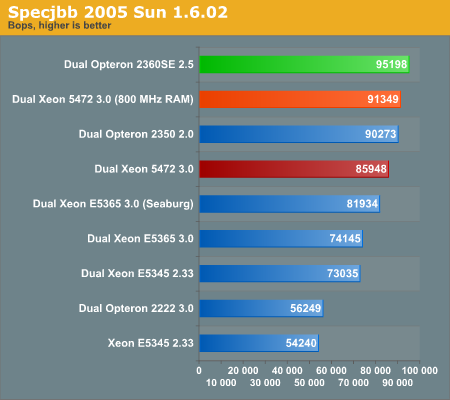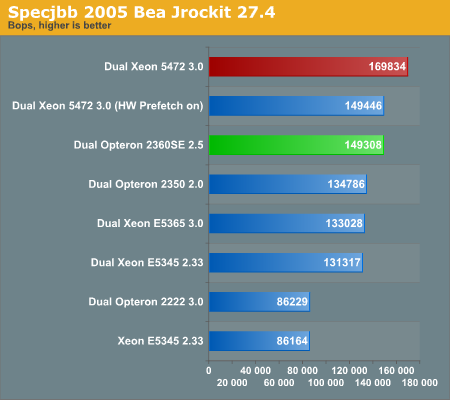AMD's 3rd generation Opteron versus Intel's 45nm Xeon: a closer look
by Johan De Gelas on November 27, 2007 6:00 AM EST- Posted in
- IT Computing
64-bit Linux Java Performance: SPECjbb2005
If you are not familiar with SPECJbb2005, please read our introduction to it here. SPECjbb2005 from SPEC (Standard Performance Evaluation Corporation) evaluates the performance of server side Java by emulating a three-tier client/server system with emphasis on the middle tier.
We tested with two JVMs:
- SUN Java HotSpot(TM) 64-Bit Server
VM (build 1.6.0_02-b05, mixed mode)
- BEA JRockit(R) (build R27.4.0-90 linux-x86_64, compiled mode)
We used the following optimizations:
- Sun JVM: -Xms2g -Xmx2g -Xmn1g -Xss128K
-XX:+AggressiveOpts -XX:+UseParallelOldGC -XX:+UseParallelGC
- BEA JVM: -Xms1800m -Xmx1800m -Xns1500m -XXaggressive -XXlazyunlocking -Xgc:genpar -XXtlasize:min=4k,preferred=512k -XXcallprofiling
The BEA JVM uses memory more aggressively, making more use of the assigned memory. A heap size of 2GB would probably result in the JVM gobbling up too much memory, which could result in errors or poor performance on our 8GB system. That is why we lowered the JVM heap size from 2G to 1.8 G. We also applied slightly more aggressive tuning to the BEA JVM, as their customers are more interested in squeezing out the last bit of performance.
We also used four JVMs per system. The reason is that most IT departments emphasize consolidation today, and it is very rare that one JVM gets eight cores. We fully disclosed our testing methods here. However, note that you cannot compare the results below with our previous findings as we use newer JVMs now.
Below you can find the final score reported by SPECjbb2005, which is an average of the last four runs.

It took us hours, but we managed to complete one run of SPECjbb with faster 800MHz DDR. It shows with four JVMs that the memory subsystem on the Xeon systems is a clear bottleneck. It is also important to note that SPECjbb is one of the most sensitive benchmarks to memory bandwidth. If SPECjbb improves 6% when we use 800MHz ram instead of 667MHz, this is probably about the maximum boost the new Xeon will get from slightly faster 800MHz memory.
Let us see how the systems fare with the BEA JRockit JVM.

BEA uses some clever compression techniques to alleviate the pressure on the memory system. However, it is a bit funny to see how the hardware prefetching gets in the way. While it boosted performance by 14% in our zVisuel Kribi 3D, it is now slowing down the SPECjbb benchmark by 14%. When we disable it, the Xeon 5472 takes the lead.
The Xeon 3GHz looks like a sports car with his wheels deeply entrenched in the mud: the raw power keeps spinning on the lack of memory bandwidth. A 3GHz chip is hardly faster than a 2.33GHz chip, and here AMD's quad-core at 2GHz beats Xeon.










43 Comments
View All Comments
Regs - Tuesday, November 27, 2007 - link
I would not expect any from vendors and wholesalers until early next year.Matter of fact I wouldn't want one until then anyhow. I would at least wait until B3 stepping.
TA152H - Tuesday, November 27, 2007 - link
Johan,From my understanding, x87 is now obsolete and not even supported in x86-64. Can you verify this? I know I had read it, from your article you state that Intel improved it, so I'm not as sure. I had assumed one of AMD's handicaps was the disproportionate, and nearly useless, x87 processing power their processors carried, but now I am not as sure. Is x87 supported in x86-64, and if not, why would Intel increase their x87 capabilities when it's clearly a deprecated technology?
JohanAnandtech - Tuesday, November 27, 2007 - link
The x87 instructions can be used in legacy mode and long mode. But it is true that Scalar SSE instructions are preferred by AMD and Intel.x87 performance as many 32 bit programs are still important (look at 3DSMAx 32 bit).
If Intel's newest Core architecture would not have improved the x87 FP it would probably have looked silly as so many 32 bit programs still use it intensively. Secondly, as you can see, things like the Radix-16 circuitry are used by both the SIMD as the x87 units.
Gholam - Tuesday, November 27, 2007 - link
Do you have any plans to benchmark Opteron vs Xeon in an ESX Server environment?DeepThought86 - Tuesday, November 27, 2007 - link
This is exactly what I was thinking of too. I want to change my mode of working to run several separate VM's, one for programming, one for Office etc and really want to know how Phenom compares to Q6600 for those uses. Well, this article looks at the server versions of those chips but for VMware the performance might be more comparable than, say, SuperPi 1M benchmarks!DeepThought86 - Tuesday, November 27, 2007 - link
I forgot to add, since Phenom would presumably also have the nested table support as Barcelona, how much performance improvement would this yield? I'd love to knowsht - Tuesday, November 27, 2007 - link
I was about to ask the same question after reading the concludingYou may feel for example that using four instances in our SPECjbb test favors AMD too much, but there is no denying that using more virtual machines on fewer physical servers is what is happening in the real world.
Since the CPUs have features that should accelerate virtualization, it would really be interesting to see how they compete there. My only addition to your request would be to add KVM as host as well (and XEN and what not as well if you care, though I really think only KVM is of interest).
JohanAnandtech - Tuesday, November 27, 2007 - link
Indeed, we are working on that. The software that we described here (http://www.anandtech.com/IT/showdoc.aspx?i=2997&am...">http://www.anandtech.com/IT/showdoc.aspx?i=2997&am... is being adapted to testing virtualized applications. We are also looking into the parameters that can really influence the results of a benchmark on a virtualized server.JohanAnandtech - Tuesday, November 27, 2007 - link
Indeed, we are working on that. The software that we described here (http://www.anandtech.com/IT/showdoc.aspx?i=2997&am...">http://www.anandtech.com/IT/showdoc.aspx?i=2997&am... is being adapted to testing virtualized applications. We are also looking into the parameters that can really influence the results of a benchmark on a virtualized server.AssBall - Tuesday, November 27, 2007 - link
Thanks, Johan.This has been one of the clearer and better proofread articles I have read here lately. It was interesting, unbiased, and insightful. I am excited to see what you get into for your next project.